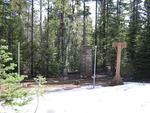
The Three Creeks Meadow SNOTEL station in Central Oregon pictured in summer 2003. A recent study found Pacific Northwest snowpack melts significantly earlier in areas scorched by wildfire.
USDA-NRCS Oregon Snow Survey and Water Supply Forecasting Program
Snowpack in the Cascade Mountains is smaller and melting out nearly a month earlier on average in areas burned by wildfire, according to a study published this month in the American Geophysical Union.
That can mean longer and more severe drought seasons for Oregon communities and ecosystems that rely on a slow, steady melting of mountain snow to meet water needs during the dry summer.
“The fact is that so much of our water supply comes from snowmelt, so that’s going to be a huge issue moving forward,” said Jeremy Giovando, a research civil engineer with the U.S. Army Corps of Engineers, who co-authored the study.
Giovando’s team used years of pre- and post-fire data from snow telemetry or SNOTEL stations across the American West to measure the average change in melt-out date and peak snow-water equivalent after major fires.
Snow-water equivalent is a measurement of how much water is contained in snowpack when it melts. Melt-out date is the day when snow-water equivalent at a SNOTEL station reaches zero.
According to the study, SNOTEL stations in the Oregon Cascades saw some of the most dramatic swings in peak snow-water equivalent and melt-out date after fire of dozens analyzed across the American West and Alaska.
The findings add to a growing body of evidence that Cascades snowpack is particularly vulnerable to the effects of climate change.
The analysis found that snowpack melted out 26 days earlier on average at SNOTEL stations in the Cascades after they burned. Peak snow-water equivalent was also about 17% smaller after a fire. On the eastern slopes of the Cascades, snowpack was about 36% smaller and melted out about 20 days earlier in areas that burned.
“Any sort of change is important, but something of that magnitude really makes a difference for water managers and water users and everyone that would depend on that runoff,” Giovando said.
When fire tears through tree canopy, it exposes snowpack to more direct sun. Charred debris can also fall onto snow, darkening it and causing it to absorb more sunlight.

The Three Creeks Meadow SNOTEL station pictured in 2017, more than a decade after the B&B Complex Fire.
USDA-NRCS Oregon Snow Survey and Water Supply Forecasting Program
Kelly Gleason, an assistant professor of ecohydrology at Portland State University, co-authored a similar study in 2021. She said the adverse effects of wildfire on snowpack can last for years in a burned area and some forests may not grow back to their pre-fire conditions.
Gleason said with more data, scientists could assemble models that help identify where snowpack is most vulnerable to fire — especially as blazes become more frequent and intense because of climate change. Those models could give resource managers a better idea of water availability after fires.
“We have these interacting challenges, threats to the future with climate change and increasing forest fires,” she said. “I think it’s really important that we understand the process, why it’s happening, how it varies in space and time, and so we can plan for it. So we’re not left blind.”
